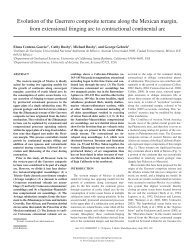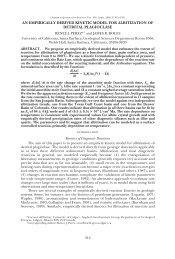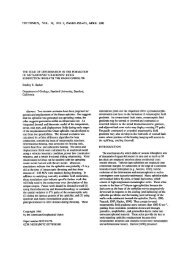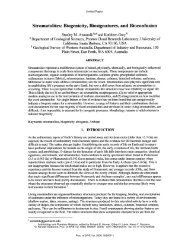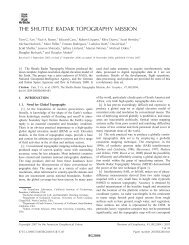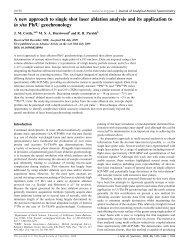Campaign-style titanite U-Pb dating by ICP - Earth Science ...
Campaign-style titanite U-Pb dating by ICP - Earth Science ...
Campaign-style titanite U-Pb dating by ICP - Earth Science ...
Create successful ePaper yourself
Turn your PDF publications into a flip-book with our unique Google optimized e-Paper software.
96 K.J. Spencer et al. / Chemical Geology 341 (2013) 84–101interfacial energies of incoherent grain boundaries and twins. The compositionof the recrystallized, Caledonian portions of the grain is distinctlydifferent from the compositions of the inherited, Precambrianportion (e.g., lower Zr and higher U/Th).There are specific regional patterns to the dates of <strong>titanite</strong> in differenttypes of rock. The <strong>titanite</strong>s in retrogressed eclogite (Fig. 9) are the sameor younger, 389–386 Ma, than eclogite U–<strong>Pb</strong> zircon, Lu–Hf garnet, Sm–Nd garnet, and Rb–Sr white mica dates (425–400 Ma). They show noinherited, Precambrian dates—as expected for eclogite, in which themafic protolith should have had ilmenite, precluding the possibility ofinheritance. These data are compatible with the formation of <strong>titanite</strong>during retrogression, as inferred from textures (Table 1). The datescould represent the time that <strong>titanite</strong> i) formed during retrogressionof the eclogite or ii) closed to diffusive(?) <strong>Pb</strong> loss during cooling;deformation-induced <strong>Pb</strong> loss in these weakly deformed rocks isprecluded.Titanite from concordant, deformed leucosomes and from discordant,nondeformed leucosomes shows equivalent ranges of Caledoniandates, from ~403 Ma to ~385 Ma (Fig. 9). Leucosome <strong>titanite</strong> in thesouth and east of the study area (and two samples from the core ofthe orogen) is partially reset from Precambrian toward Caledoniandates; the inherited components suggest that ~1.6 Ga and ~0.96 Gacomponents are both present, as identified <strong>by</strong> Tucker et al. (1990). Theoldest Caledonian leucosome <strong>titanite</strong> dates, ~408–400 Ma, are in the centerof the study area. Titanites south and north of that are chiefly400–392 Ma, but there are a few dates as young as ~385 Ma. The datesof the nondeformed leucosome <strong>titanite</strong>s could represent the time thatthe <strong>titanite</strong> crystallized or closed to <strong>Pb</strong> loss; given the high inferred closuretemperature for <strong>titanite</strong> (see below), the former is more likely. The datesof the deformed leucosome <strong>titanite</strong>s could have the same meaning or heraldthe time of deformation-induced <strong>Pb</strong> loss.The <strong>titanite</strong>s from mylonitic gneisses and mylonites are the youngest,at 389–377 Ma (Fig. 10). All except one are within the “strongScandian deformation” domain of Hacker et al. (2010). Because the<strong>titanite</strong> dates in these strongly deformed rocks are younger thanthose from surrounding rocks that experienced the same temperaturehistory, they most likely represent the time that the <strong>titanite</strong> formed orclosed to <strong>Pb</strong> as a result of deformation.The <strong>titanite</strong> in the gneiss and granulites are generally younger tothe northwest, but show considerable inheritance of ~1.6 Ga, possibly~1.2 Ga, and 0.96 Ga components (Fig. 11). When all of the <strong>titanite</strong>dates are considered together (Fig. 12), there is an overall patternsimilar to that recognized farther north <strong>by</strong> Tucker et al. (1990). Inthe southern and eastern parts of the study area where temperatureswere as low as 650 °C, most of the <strong>titanite</strong> is Precambrian. In the northand west where temperatures were as high as 800 °C, <strong>titanite</strong>s are asyoung as 378 Ma. This pattern of northwestward younging isinterrupted <strong>by</strong> two domains where old <strong>titanite</strong> U–<strong>Pb</strong> dates are preserved:one in the southwest (~15×30 km) partially overlapping theNordfjord UHP domain where temperature exceeded 700 °C, and oneFig. 9. Titanite dates (Ma) from retrogressed eclogite are younger than eclogite dates; they are oldest in the south (397 Ma) and youngest in the north (386 Ma). Titanite dates (Ma)from concordant, deformed leucosomes (ellipses) and from discordant, nondeformed leucosomes (circles) show the same range of Caledonian dates: ~404 Ma to ~384 Ma. Eachsample location is colored according to date. Samples with identifiably different core and rim dates are denoted as rim_date[core_date]. “Caled.” indicates Caledonian date thatis poorly defined because of low radiogenic/common <strong>Pb</strong> ratio. “>” indicates oldest 207<strong>Pb</strong>-corrected date of sample and that additional analyses would likely reveal older dates.All dates have uncertainties of 2% unless otherwise indicated.



